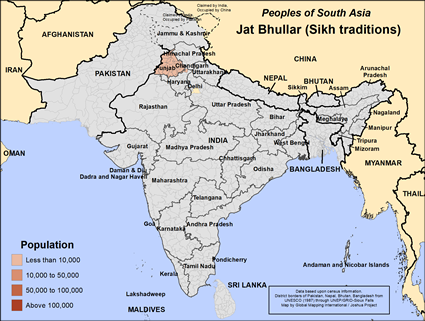Jat Bhullar (Sikh traditions) in India

Photo Source:
Anonymous
|

Map Source:
People Group data: Omid. Map geography: UNESCO / GMI. Map Design: Joshua Project
|
| People Name: | Jat Bhullar (Sikh traditions) |
| Country: | India |
| 10/40 Window: | Yes |
| Population: | 79,000 |
| World Population: | 79,000 |
| Primary Language: | Punjabi, Eastern |
| Primary Religion: | Other / Small |
| Christian Adherents: | 0.00 % |
| Evangelicals: | 0.00 % |
| Scripture: | Complete Bible |
| Ministry Resources: | Yes |
| Jesus Film: | Yes |
| Audio Recordings: | Yes |
| People Cluster: | South Asia Sikh - Jat |
| Affinity Bloc: | South Asian Peoples |
| Progress Level: |
|
Introduction / History
The Bhullars are among the oldest Jat gotras (clan or lineage) in India. There are different opinions as to the origin of the Jats, but most seem to recognize them to be from Indo-Aryan tribes native to the Punjab region that straddles modern Pakistan and India. There is a theory suggesting that they may be the predecessors of Gypsies. They probably reached Egypt with the Muslim conquerors, lived in Afghanistan before the Muslims, and invaded China with the Mongol Army. They also proved to be a threat to Tamarlane in Persia and Uzbekistan in the 1400s.
There are very few records concerning Jats prior to the 1600s. They rose to prominence following the 1669 Jat uprising against Mughal rule, and they ruled various princely states throughout the 18th century. For centuries the Jat lifestyle was designed to foster a martial spirit. Whenever they lost their kingdoms, Jat people became landlords who were ready to defend their land against any invaders.
After 1858, under the British Raj, the Jats were known for their service in the Indian Army, being categorized as a "martial race" by the British. For a couple hundred years Jats were a force that could not be ignored by South Asians or British imperialists.
Where Are they Located?
Sikh Bhullar Jats live in the Indian states of Uttar Pradesh, Haryana, and especially Punjab where Sikhism originated. Some also live in Pakistan.
What Are Their Lives Like?
Bhullar Jats have a very good self-image. "Men may come and men may go, but I go on forever," is a well-known Jat proverb. They are brave, hardworking people who possess both the desire and ability to rule. It has been said that no Jat wants to be ruled. Rather, he desires to have power over a group if not over an area. They take great pride in their ancestry. In fact, all the Jats in a particular village consider themselves to be the descendants of the man whom they believe founded it by the power of the sword.
Conservative by nature, the Jats rarely marry people from other people groups. From about 1650 AD onwards marrying within same clan became more common. The modern-day litmus test that Jat people use in marriage is if the girl and boy must not have the same great-great-grandparents (not related for four generations). If they are from the same clan but are not directly related for four generations then it is considered acceptable for them to marry.
Physically, the Jats are usually taller and heavier than most of their neighbors. Because of their larger build, their reputation for violence, and the fact that they control much of the land and village income, they are generally feared by other communities.
Most of the Jats live in rural areas, and they are usually landowners. A small percentage are traders and laborers. Today, the Jats are well read, and some occupy high positions in academic and technical arenas. The Jat peoples are one of the most prosperous groups in India on a per-capita basis (Punjab, Haryana, and Gujarat are the wealthiest of Indian states). Haryana has the largest number of rural crorepatis (similar to "millionaires") in India, all of whom are Jats. Ironically, because they value thriftiness and diligence, the Jats are often regarded as miserly.
What Are Their Beliefs?
Of all three major Jat religious groups, the Sikhs are the most likely to hold power and prestige. A number of Sikh Jat people belonging to the political classes have produced many political leaders, including the 6th Prime Minister of India, Prime Minister Chaudhary Charan Singh.
Until recent times, the Jat Sikhs seemed to be the least meticulous in their observance of Sikh traditions. Many Jat Sikhs observe Hindu funeral rites and employ Hindu Brahmins as family priests. Sikh Jats observe many ceremonies, especially rites of passage such as initiation into adulthood. Wedding ceremonies are especially important to Jat Sikhs.
During a wedding ceremony Sikhs make a square enclosure known as chaonari and perform a fire sacrifice. The couple walks seven times around the chaonari with their right hand inward. A Jat Sikh cannot take a wife from his own section. Widow remarriage is allowed but she cannot marry her younger brother-in-law or the near relatives of her deceased husband.
What Are Their Needs?
Many Jat communities need clean drinking water and proper health care facilities. Christian medical teams and humanitarian aid workers are needed to work among them and show them God's love in practical ways.
Missionaries, Christian broadcasts, and evangelistic literature are needed to effectively reach the Jats with the light of the gospel. Most importantly, they need people who will begin to intercede for them, tearing down the strongholds that are keeping them in spiritual bondage. Only then will their hearts be prepared to receive the good news as it is presented to them.
Prayer Points
Ask the Lord to send out additional laborers to work among the Sikh Bhullar Jats.
Pray that Christian doctors, nurses, and humanitarian aid workers will have opportunities to share the love of Jesus with the Bhullar Jats.
Ask God to save key Jat leaders who will boldly proclaim the gospel to their own people.
Pray that churches and mission organizations will accept the challenge of adopting and reaching the Bhullar Jats.
Ask God to raise up teams of intercessors who will faithfully stand in the gap for the Jats.
Pray for a disciple making movement to emerge among every Jat clan and community.